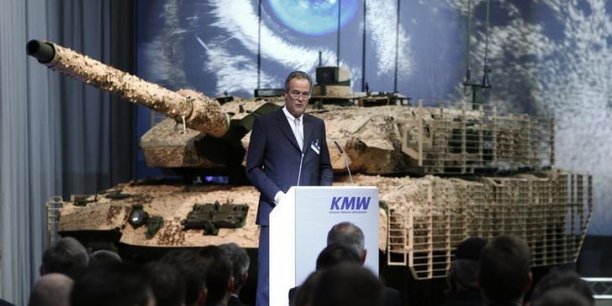By Pierre Tran
Paris – KNDS, a Franco-German joint venture in land weapons, seeks a more streamlined management with the appointment of Philippe Petitcolin as chairman and Frank Haun as the sole chief executive, the French finance and defense ministries said Dec. 14 in a statement.
The appointment of a single chief executive officer of KNDS replaces the previous agreement of two CEOs, one drawn from France, the other from Germany, with Haun sharing the post with Stéphane Mayer.
Mayer now leaves the joint venture and also steps down as executive chairman of Nexter, the ministries said.
Nexter is the French partner of the 50/50 joint venture KMW and Nexter Defense Systems (KNDS), with privately owned Krauss-Maffei Wegmann its German partner. Setting up the joint holding company was a step toward European industrial consolidation in the land sector.
Meanwhile, KNDS’s projects list includes building a new European main battle tank, to sell into the East European market, a defense executive said. That tank would be all new, distinct from a concept model presented at the 2018 Eurosatory trade show, built from a turret from the French Leclerc and chassis from the German Leopard 2.
On the KNDS appointments, these aimed for “greater efficiency and integration to the benefit of clients,” the ministries said. A French successor to Mayer will be appointed as Nexter CEO in the next few weeks, and that executive will hold the post of operations director at KNDS.
KNDS will also be slimmed down to one board of directors.
“The shareholders have decided to streamline the governance structure by establishing a single board of directors replacing the existing supervisory and management boards,” Nexter said Dec. 14 in a statement.
The chairman and CEO posts will rotate every four years, an industry executive said. The changes marked a milestone, granting more power to KNDS in the pursuit of integration.
There was no great surprise Haun was named as sole CEO, as news had leaked into the press last week, but the “brusque” departure of Mayer was unexpected, a defense official said.
The lack of a named successor to Mayer as Nexter CEO stood in contrast to KMW’s announcement Ralf Ketzel will be its CEO, stepping up from his previous position as chief business development officer.
The slimmed down structure marked the end of a five-year trial period for KNDS.
In 2015, Emmanuel Macron, the then finance minister, told the French parliamentary lower house there would be a five-year trial period to see if the Franco-German alliance worked, and if it did not, the deal could be unwound.
The creation of separate chairman and CEO posts echoed the shakeup at Airbus, which previously, under political pressure, shared its top management between French and German executives based on passport rather than management skill.
The appointment of Haun and Petitcolin will be closely watched as both have strong personalities. The former was seen as the senior partner when the two CEO posts were held.
Petitcolin, who will take up the chairman’s post March 1, is CEO of Safran, the aero-engine builder. Petitcolin has direct experience in working with tough industrial partners.
Safran is prime contractor on the new engine for the next generation fighter in the Future Combat Air System.
German partner MTU was reported to have been keen to share that pole position and it took some time to make clear the prized prime contractorship was reserved for Safran.
MTU finally accepted Safran’s leadership and agreed to be main partner in the phase 1A study for FCAS, and only then the companies agreed to form an engine joint venture.
The main project for KNDS is to build the Main Ground Combat System, which consists of a heavy tank and associated vehicles to replace the Leclerc and Leopard 2.
There is a project for new artillery, the Common Indirect Fire System, to replace the Caesar, but there has not been much work on that recently, the executive said.
There is also the project for a new European main battle tank to replace the vast fleets of Russian tanks in Eastern Europe.
That new tank will need to carry a low-price tag, be well armed and well protected. There will be stiff competition from the Israeli Merkava and South Korean K2 Black Panther, the defense official said.
Featured photo of Frank Haun credited to Reuters.


